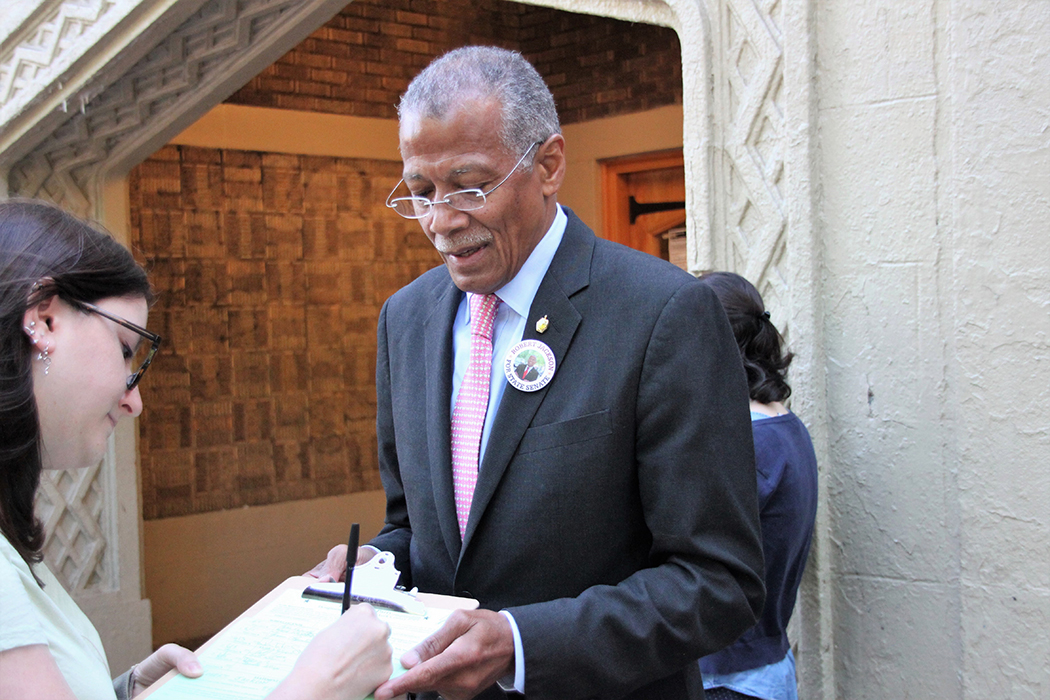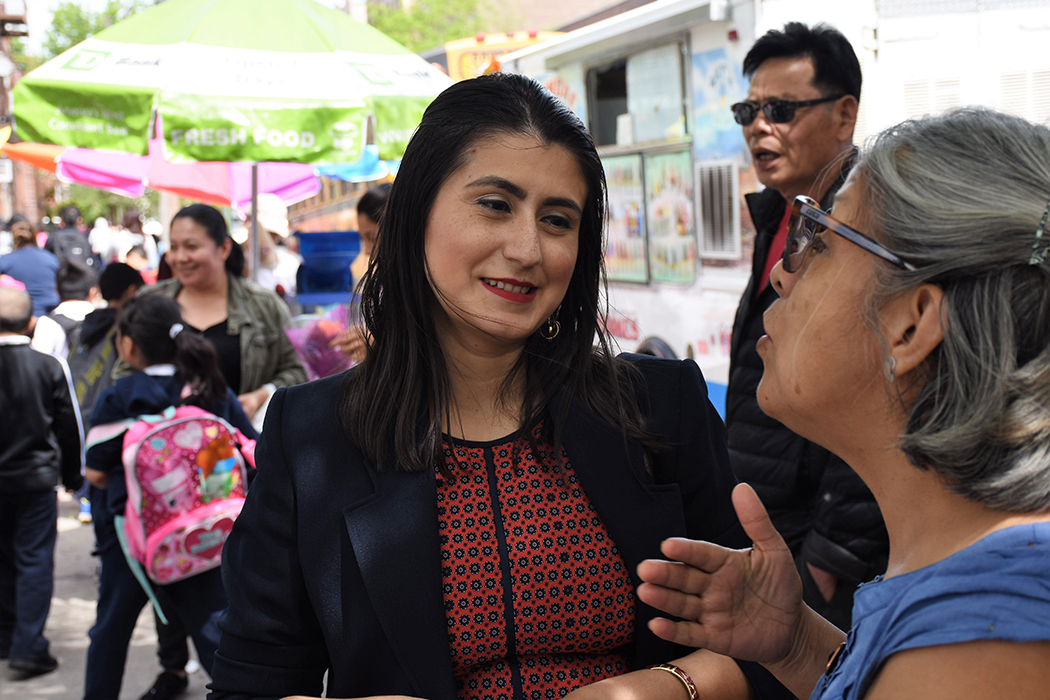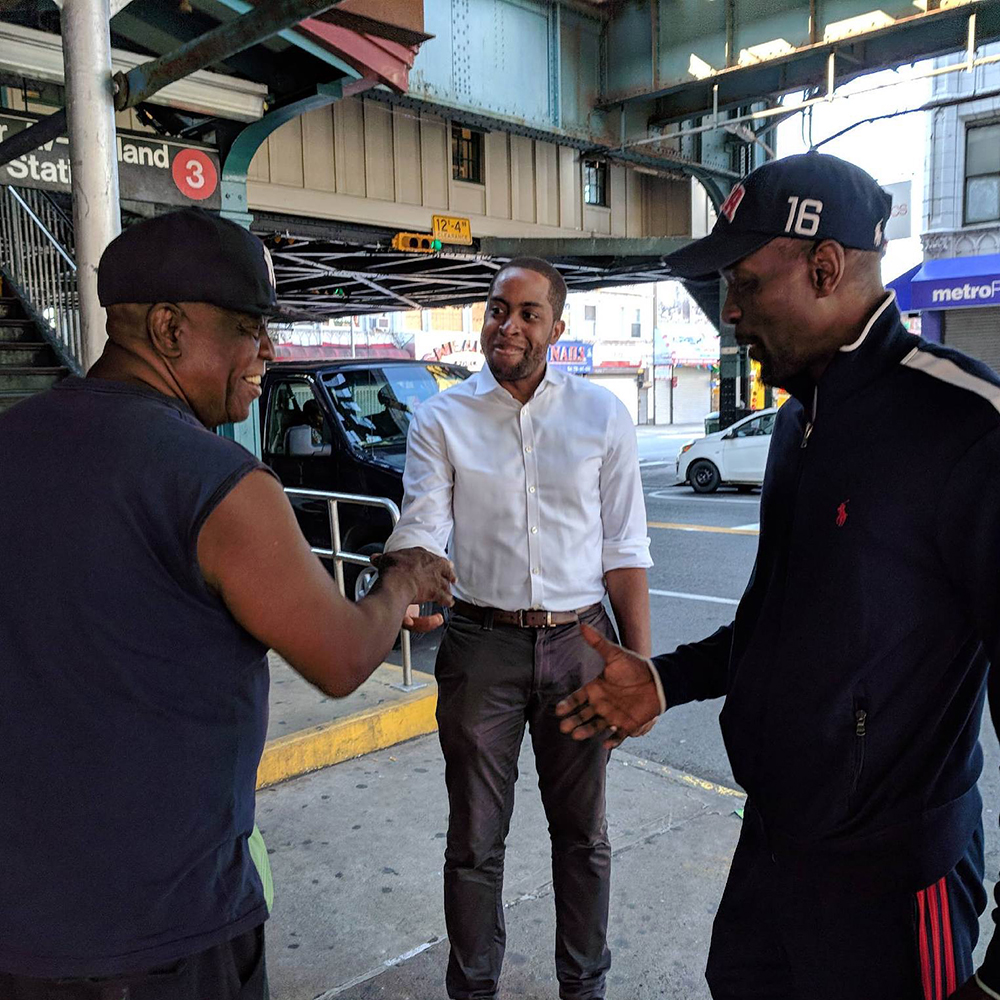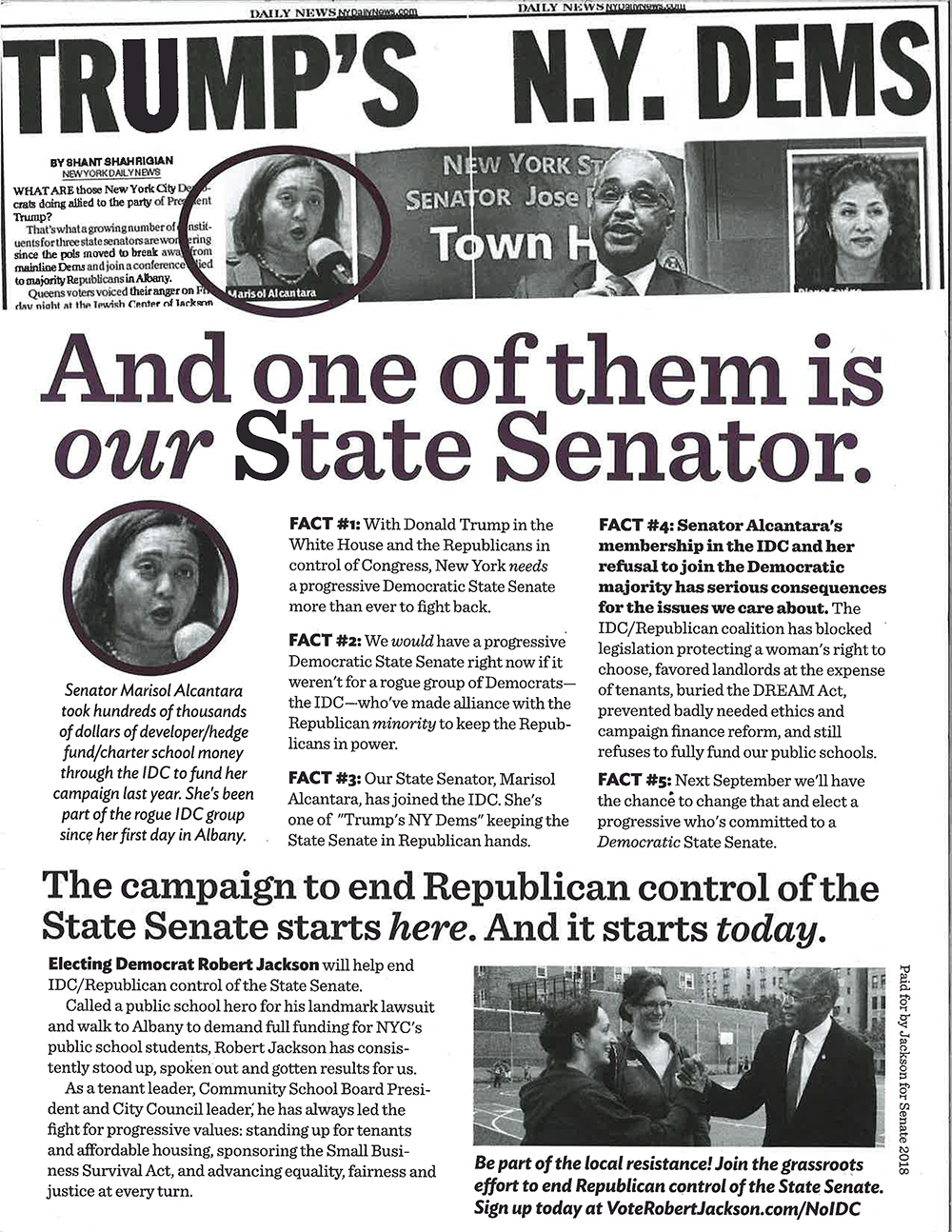On a muggy night in June, hundreds of Queens residents packed into the Jackson Heights Jewish Center for a candidate forum. Though Rep. Joseph Crowley and Alexandria Ocasio-Cortez squared off last, it was the second debate between state Sen. Jose Peralta and Jessica Ramos that got the most heated.
Until April, Peralta had been a member of the Independent Democratic Conference, a group of eight breakaway Democrats who helped Republicans stay in power. Ramos hopes to unseat him.
The contentious debate kicked off with a question about Peralta’s decision to join the IDC. Peralta defended his track record and pointed to the money he has been able to bring to district, drawing a smattering of applause. Ramos sought to tie the conference to President Donald Trump, noting that Peralta announced his decision to join the IDC the same day Trump announced his first travel ban on Muslim majority countries.
“What the hell’s that got to do with anything?” a man yelled from the crowd. Someone else angrily shushed him.
When Peralta spoke about his New York DREAM Act, a measure that would help young, undocumented immigrants get access to financial aid for college, another crowd member interjected, “But you can’t pass it!”
“We were lied to,” Ramos said of the DREAM Act, to loud applause and murmurs of agreement that led the moderator to ask the crowd to settle down – a request he would have to make several more times over the course of the debate.
The loud and impassioned exchanges that night reflect the feelings of candidates and voters alike as each of the members of the now-defunct IDC face contested primaries, some for the first time, others for the first time in years. But though such anti-IDC sentiment has propelled many of those challenges and thrust them into the public eye, it alone may not decide any of the contests, with a flurry of other unique factors playing a role in individual races.
The eight challengers taking on former IDC members all face uphill battles. Unseating incumbents is a difficult endeavor to begin with, and most are first-time candidates taking on powerful and well-financed incumbents.
Even Gus Christensen, chief strategist of the activist group NoIDCNY, said that he initially thought his organization would be lucky to get even two wins. He cited Alessandra Biaggi, the primary challenger taking on former IDC leader Jeff Klein, as an example, saying he had originally hoped that her campaign would simply help others win. “If you had gotten me to answer honestly six months ago, I would have said I love Alessandra Biaggi, she is the greatest sacrificial lamb we have ever taken to war,” Christensen told City & State.
But a lot has changed in the past six months. Actress Cynthia Nixon announced her far-left campaign for governor, the IDC dissolved under pressure from Gov. Andrew Cuomo, and Ocasio-Cortez upset Crowley in their congressional primary, defying conventional expectations and shaking up the political landscape in New York City. After her win, anti-IDC activists convinced former New York City Comptroller John Liu to take another shot at state Sen. Tony Avella, the only former IDC member running unopposed. Liu joined seven other challengers – Biaggi, Ramos, Zellnor Myrie, Robert Jackson, Jasmine Robinson, Rachel May and Julie Goldberg – in taking on the ex-IDC lawmakers.
Liu had previously run against Avella in 2014, after the state senator joined the IDC, failing to unseat him in a close but decisive election. But the outcome might be different this year. Progressive energy and support has continued to grow to a point where Christensen can now say that when he predicts that five or six candidates will win, he really means it.

The swell of support to unseat the former IDC members can be traced back to the election of Donald Trump in 2016. His victory over Hillary Clinton changed the political landscape by energizing activists who had never been active before and getting more constituents to pay closer attention to local politics. It led to the formation of groups like NoIDCNY and True Blue New York whose express purpose is to oust IDC members and form a Democratic majority in the state Senate with loyal Democrats.
“Those of us who were aware of it knew what a terrible thing it was and we weren’t really hopeful anything could be done about it,” Christensen said. “And then Donald Trump got elected.”
Shortly after its formation, the IDC in early 2011 allied itself with the Republican majority. Then made up of four members – state Sens. Klein, Diane Savino, David Valesky and David Carlucci – those Democrats were rewarded with the perks of being in the majority, like coveted committee posts and the stipends that come with them. In 2013, they formed a power-sharing agreement in exchange for helping the GOP maintain their majority. The rationale behind the deal was that by sharing power, the IDC would help to pass progressive legislation that would otherwise never make it to the floor of the state Senate under Republican control.
This was the state of Albany politics until this past April, when Cuomo, facing pressure from the left in the form of primary challenger Nixon, brokered a deal for the conference to dissolve and its members to rejoin the fold. But the challengers refused to back down, and the resistance has only continued to grow. While the majority of the incumbents had been with the IDC for some time and won re-election while part of the conference, the three newest members – Peralta and state Sens. Jesse Hamilton and Marisol Alcantara – have not.
Alcantara is not only one of the newest IDC converts, but is also the least experienced legislator among the eight. Hamilton is also less entrenched, having only been elected in 2014. Although Peralta has represented his district for many years, his decision to join the IDC seemed to stir up the most controversy in the district. Add to these facts to their short tenure with with conference and strong opponents, Peralta, Hamilton and Alcantara have found themselves on uniquely vulnerable positions among their colleagues as they fend off attacks.

Peralta’s decision to jointhe IDC was the main impetus behind Ramos’ decision to run. Like many of her fellow Queens residents, she attended a rowdy town hall in February of 2017 where Peralta faced harsh backlash over his new allegiance to the IDC. “I certainly saw how upset my neighbors were, and I was quite frankly. I couldn’t stop shaking my head,” Ramos said.
Peralta said through a spokesman that he is confident that his constituents will remember all that he has done for the community, such as securing $15 million for immigrant legal defense and large increases to school funding.
Peralta has faced perhaps the most obvious resistance after leaving the fold of the mainline Democrats. Although he was one of the three most recent converts, he alone made his choice after Trump became president, which Ramos said was a big deal in her community. She said she likely would not have decided to ran had Peralta remained aligned with the mainline Democrats. But when she made her decision, she was all in. “What I didn’t want from the beginning was to be just to be a statement campaign. If I was going to run, it’s because I’m running to win.”
Ramos said that she has found that many people she has spoken to while campaigning are aware of the IDC, are disappointed with their state senator and desire change. However, she doesn’t make Peralta’s allegiance to the breakaway conference her selling point when canvassing. In fact, her campaign literature makes no mention of the IDC, nor of Peralta’s cooperation with Republicans. The facts are also absent from the front page of her website, mentioned only briefly at the top of a page entitled “Her Vision,” with more details further down the page. Her descriptor simply as a “real Democrat” is far more prominent. But Ramos doesn’t think that those explanations are missing, per se. She prefers to focus instead on her policy agenda, such as eliminating vacancy decontrol for rent stabilized apartments and providing better funding for public schools.
Ramos doesn’t have a rehearsed pitch she gives to voters when she knocks on doors, seeking to have conversations with potential voters. On the second door she knocked on while canvassing at the public housing complex Woodside Houses in July, a young woman opened the door. Ramos introduced herself simply as “Jessica” and offered to answer any questions the woman had. Their conversation lasted about five minutes, covering Ramos’ platform and Peralta. “I actually need to start paying more attention to this,” the woman, Martha, said at the end of the conversation.
Every interaction was different. Sometimes, Ramos would lead with Peralta’s cooperation with the Republican majority in the state Senate. Other times she would start with her policy agenda. Still others, she would simply offer to answer any questions.
Ramos got many additional positive responses after Martha and in-depth conversations throughout the next hour of canvassing. “I don’t think anyone is gonna stay home this time around,” one man told her after they spoke. “You gonna win.”
Although progressives like to point to Ocasio-Cortez’s stunning upset victory over Crowley in June as evidence of surging progressive activism in the state, it is impossible to make one-to-one comparisons with other races in the state. Yet the race between Ramos and Peralta is one of the few with that victory could be interpreted as a bellwether of any sorts. Senate District 13 lies largely within the 14th Congressional District and Ramos is tapping into the same sort of groundswell support that led to Ocasio-Cortez’s victory.
One Queens Democratic insider who requested anonymity to speak freely said that Ocasio-Cortez changed the perceptions around the state Senate race between Ramos and Peralta. “Most people I spoke to before the congressional primary thought Jose was going to hold on. … Now, I think most people I speak to think Jessica is going to win,” the insider said.
Although Ramos is a first-time candidate, she is not unknown to Queens’ political organizations. As a former district leader, the insider said Ramos has friends within the party, adding that she has more grassroots support, the kind that Ocasio-Cortez capitalized on.
Another Queens insider who requested not to be name in order speak freely said that many of the Democratic clubs in the county endorsed Peralta simply because the county party backed him and they felt they needed to. “Look, nobody was lighting a fire saying ‘rah rah.’ They felt they had to do it to live up to their end of the deal to dissolve the IDC,” the insider said.
That deal appeared to unravel when Crowley lost. Only a few day later, New York City Council Speaker Corey Johnson, a staunch Crowley ally, announced his support for Ramos and three other IDC challengers, before extending his support to the other anti-IDC candidates in the city.

Hamilton has received criticism for accepting money from the Real Estate Board of New York, or REBNY. He has also accepted large sums from the State Senate Independence Campaign Committee, the campaign account of the IDC, which the real estate business has also donated to heavily. Hamilton told City & State that the housing crisis in his community is of the utmost importance to him and pointed to money he has brought into his district for community organizations, immigration services and legal aid housing services thanks to his decision to join the IDC. He added that whereas he has been involved in the community for 20 years, Myrie is a virtual unknown.
This is something Myrie himself acknowledges. Although a first-time candidate like Ramos, he does not have the benefit of having already been involved in county politics. “People don’t know who the fuck I am,” Myrie told City & State while waiting for a campaign aide to canvass at the Ebbets Field apartment complex in July. To each person who opened a door, he gave a 30-second introduction, leading with his roots in the community (“I went to P.S. 161 around the block from here”), his immigrant background (“Both my parents came from another country”) and his experience with housing (“(My parents) raised me in a rent stabilized apartment”). To close, Myrie said that despite being elected a Democrat, Hamilton helped empower Republicans in the state Senate.
Although many interactions ended after Myrie’s pitch with head nods and mumbles about how they’ll look him up later, a handful reacted with indignance when he mentioned Hamilton’s cooperation with Republicans in the state Senate and passionately agreed about the need to address the area’s affordability crisis. “We know that,” one tenant told Myrie when he mentions Hamilton’s cooperation with Republicans. Another told Myrie after reacting with surprise to Hamilton’s association with the IDC: “I’m gonna read up on this, man, I like what you’re on, I like where you’re going.”
Like Ramos, Myrie does not consider the IDC to be a driving force of his messaging. While he does have a “No IDC” tab featured at the top of his website that explains what the conference is, he makes no mention of it or Hamilton’s part in a power sharing deal with the GOP on the campaign flyers he hands out.
But according to one Brooklyn Democratic insider who requested not to be named in order to speak freely, the IDC is not the issue that will decide the race. Rather, overarching politics have much more of a hand in deciding the race, specifically the power struggle between Brooklyn Borough President Eric Adams and Rep. Hakeem Jeffries. Hamilton is Adams’ protege, replacing him in the state Senate in 2014. Hamilton won a decisive victory in that Democratic primary against the Jeffries-backed candidate Rubain Dorancy. At Hamilton’s victory party, Adam’s reportedly told supporters “We showed them who the real kingmaker in Brooklyn is.”
With Jeffries’ recent endorsement of Myrie, the state Senate race appears to be another proxy battle between the congressman and borough president. But over the years since the Hamilton-Dorancy race, Jeffries has flexed his muscle in backing other successful candidates in Central Brooklyn. “It is more about who controls the power over there,” the insider said.
Beyond the bigger issues at play, residents have also seemed to indicate that the IDC is not a defining issue in the race. At a candidate forum in July, constituents appeared to care more about Hamilton’s ties to real estate as it relates to the affordability crisis in the community than about his allegiance with the IDC. Reportedly, the conference was not named once, a stark contrast to Ramos’ candidate forum in Queens.

“I’m the savior in many ways,” Jackson told one of the first people he spoke to while campaigning outside Zabar’s supermarket on the Upper West Side in July. (The store is technically one block outside of his district.) He proceeded to explain to her what the IDC is, progressive legislation he said has failed to pass because of it, and Alcantara’s former allegiance to it.
This is not Jackson’s first time around the block – he served in the New York City Council for 12 years. He describes nearly everyone he met while petitioning in Washington Heights as his neighbor. Jackson also ran for Manhattan borough president in 2013 and has run for the state Senate seat he is currently seeking twice before, including in a close 2016 race against Alcantara where she won only by about two percent more of the vote than him. Jackson found her decision to join the IDC indefensible and announced that he would run against her in May of 2017.
“Party affiliation means a lot in New York because it tells you where your heart is at, ok? Sometimes we have to suffer as a family in order to benefit everyone,” Jackson told City & State. “They’re being selfish. They’re not helping the entire family.”
Alcantara told City & State that she is a tried and true progressive who supported U.S. Sen. Bernie Sanders for president in 2016. She said her decision to join the IDC was because the breakaway conference gave financial her support when other progressive groups failed to even endorse her.
In the 2016 primary, which included four people in total, the vote was largely split between Alcantara, Jackson and Micah Lasher, a white lawyer from the Upper West Side of Manhattan. This time around, Lasher is not running and has thrown his full support behind Jackson since the time he first announced. While every person who voted for Lasher will not necessarily vote for Jackson in September, the endorsement will likely help him tap into the white, Upper West side progressive vote that Lasher won in 2016. Jackson also has the support of lawmakers who previously supported Lasher, like Assemblywoman Linda Rosenthal, who represents the Upper West side.
This represents an important part of the electorate, an area that often has higher voter turnout and very active Democratic clubs. Energy among those living there seemed apparent as many who spoke with Jackson and his volunteers seemed aware of the very state politics that Jackson is campaigning on. One woman he spoke with summed it up succinctly: “We West Side liberals are very psyched for this next round of elections.”
NEXT STORY: Grassroots campaigns compete in Queens


